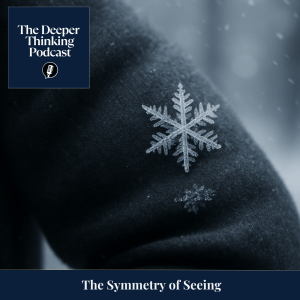
Monday May 19, 2025
The Symmetry of Seeing: Kepler, Constraint, and the Shape of Perception - The Deeper Thinking Podcast
The Symmetry of Seeing: Kepler, Constraint, and the Shape of Perception
For those drawn to quiet forms of understanding, where science becomes metaphor and attention becomes care.
Walking through a snowstorm in 1610, Johannes Kepler forgot the gift he was meant to bring—but noticed the snowflakes. That absence led him to see something else: a structure repeating without exactness, a kind of patterned insistence. This episode explores what symmetry reveals when we look past perfection and toward perception. What if symmetry isn’t just beauty—but memory? Not design, but constraint? And what if the act of noticing itself is a kind of ethical presence?
Drawing from philosophy of science, phenomenology, and the poetics of observation, this episode moves from snowflakes to quantum mechanics, from natural symmetry to psychological inheritance. We reflect on how patterns trap as well as free, and how attention becomes a moral act—especially when we look gently, without trying to solve.
With quiet references to thinkers like Simone Weil, Maurice Merleau-Ponty, and Ilya Prigogine, we explore symmetry not as perfection—but as echo. Not as a solution, but as a way to remain with what repeats. The snowflake melts. The question stays.
Reflections
This episode dwells in the soft space between knowing and seeing. Here are a few thoughts that followed:
- Symmetry is not always perfection—it is often the record of restraint.
- The mind returns to what it cannot name. That return is a kind of seeing.
- Some patterns free us. Some bind. Noticing is what begins to loosen the grip.
- The flake doesn’t repeat—but the angle does. Attention works the same way.
- Even inherited structures can be held with care when we stop performing and start perceiving.
- What falls isn’t always lost. It may just be changing form.
- Ethics begins in how we look—not what we know.
- And sometimes, the most beautiful insights arrive when we forget the gift and see what’s falling.
Why Listen?
- Reimagine symmetry as constraint, not control
- Trace how natural form reveals cognitive and emotional structures
- Consider perception itself as a moral and aesthetic act
- Engage with Weil, Merleau-Ponty, and Prigogine on pattern, perception, and temporality
Listen On:
Support This Work
If this episode stayed with you and you’d like to support the ongoing work, you can do so gently here: Buy Me a Coffee. Thank you for being part of this slower conversation.
Bibliography
- Kepler, Johannes. On the Six-Cornered Snowflake. Trans. Colin Hardie. Oxford: Clarendon Press, 1966.
- Weil, Simone. Gravity and Grace. Routledge, 2002.
- Merleau-Ponty, Maurice. Phenomenology of Perception. Routledge, 2012.
- Prigogine, Ilya. The End of Certainty. Free Press, 1997.
Bibliography Relevance
- Johannes Kepler: Introduces the initiating event and foundational metaphor of natural form.
- Simone Weil: Reframes attention as an act of ethical precision.
- Maurice Merleau-Ponty: Grounds perception as embodied meaning.
- Ilya Prigogine: Links pattern emergence with thermodynamic temporality.
Symmetry may begin in nature—but it returns in how we choose to see.
#Kepler #Symmetry #PhilosophyOfScience #Phenomenology #Weil #MerleauPonty #Prigogine #Attention #Perception #TheDeeperThinkingPodcast #PatternRecognition #EthicalSeeing #StructuralBeauty
No comments yet. Be the first to say something!